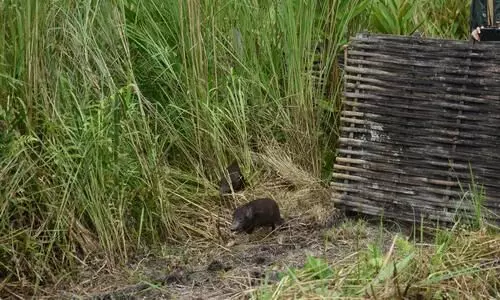
IANS Photo
Guwahati, Oct 1: Eighteen captive-bred pygmy hogs were released in the sprawling Manas National Park of Assam on Saturday by the Pygmy Hog Conservation Programme (PHCP).
This is for the fourth time pygmy hogs have been reintroduced to Manas National Park by the PHCP after successful releases in 2022, 2021 and 2020.
Forest officials said that with the release of 18 pygmy hogs the total number of this critically endangered species released at this site increased to 54 and the PHCP has targeted to increase the number to 60 pygmy hogs in Manas Park by 2025.
The programme, which is made up of founding partner Durrell Wildlife Conservation Trust, along with the IUCN/SSC Wild Pig Specialist Group, Assam Forest Department, Union Ministry of Environment and Forests and Ecosystems -- India and Aaranyak, northeast India's leading biodiversity conservation organisation as delivery partner, has been working to bring this precious species back from the brink after it was previously thought to be extinct in the 1970s.
The PHCP started its work in 1996, where two males and two females were captured from the Bansbari range of Manas National Park.
The reintroduction of captive bred hogs to the wild began in 2008.
Prior to releases in Manas National Park, the PHCP selected other appropriate grasslands in Assam for reintroductions of the pygmy hog.
Fifty-nine pygmy hogs were released in Orang National Park, which is located approximately 120 km from Manas, between 2011 and 2015.
The reintroductions in Orang have been particularly successful as the population is now estimated to be 130 hogs.
This is made even more exciting as the lifespan of a pygmy hog in the wild is around 7 years, so this population is likely to be made up of entirely wild born hogs.
Pygmy hogs are extremely shy and secretive in the wild, remain hidden in tall dense grass and rarely emerge in the open, which has made monitoring them at the reintroduction site in Orang National Park a challenge.
The PHCP team of conservationists have worked through this by employing camera traps and undertaking sign surveys, where the team look for pygmy hog pellets, nests, foraging marks, and footprints.
PHCP Project Director, Parag Jyoti Deka said: "The results of the Orang camera trap and sign surveys show the real impact that our captive breeding and release programmes can have towards saving species from extinction. With the inspirational dedication of the Durrell team, and with the support of our partners Aaranyak and Assam Forest Department in Assam, we have been able to restore a self-sustaining population of pygmy hogs, bringing back an integral part of the ecosystem of the grasslands of Orang National Park.
"This has been achieved alongside an effective science-based programme of habitat restoration, benefiting not only the pygmy hog, but also other grassland specialist species."
As part of its rewilding strategy, the PHCP will continue to maintain a population of around 80 captive hogs at its two centers in Assam and breed more hogs for release.
The strategy for monitoring hogs after their release continues to develop.
